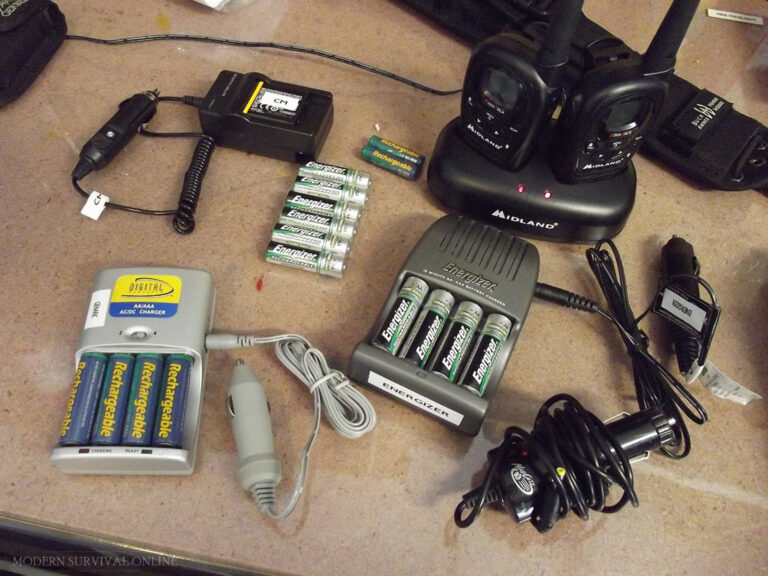When the power goes out or you are in the middle of a survival situation where you need a fire it is easy to feel overwhelmed if you don’t have your usual fire-starting kit or expert skill with primitive fire-starting techniques.

Fortunately, there is an easy, improvised way to get your fire started: using a common battery.
With just some basic scavenged or repurposed materials and a little knowledge, you can safely use a battery as an effective fire starter on demand.
In this article, I’ll explain several methods on how to do that so that you’re prepared when the time comes.
How Is It Possible To Start a Fire With a Battery?
We can use batteries to start a fire by exploiting the principles behind their function. Batteries store and release electricity by means of a chemical reaction involving two different substances – the anode and cathode.
When a conductive material is placed between these two terminals, it allows electricity to flow from one terminal to the other.
When installed in any of the innumerable devices that use them, it provides the device with power.
However, one of the necessary byproducts of producing electricity, and electricity conducting through a material, is heat.
Depending on the strength of the battery and the type of material we use with it, the item conducting the electricity can get hot. Real darn hot! We are talking glowing orange, hundreds of degrees hot.
By touching this screaming hot material to our tinder or kindling, we can easily ignite a fire.
The speed and reliability of these methods (assuming the battery has a good charge) are what makes this an invaluable method in your survival skills toolbox.
You Can Use AA, AAA, or 9V Batteries
One thing to keep in mind is that you can use these methods with basically any battery you can lay your hands on, though some batteries work a lot better than others.
Tiny batteries used in watches or small toys are almost never sufficient, but many common sizes are. This includes AA, AAA, and 9V batteries.
So long as you can access the terminals, they offer decent voltage, and are holding a good charge, they should work just fine.
The examples below reference AA and 9V batteries because they’re the most commonly available, but feel free to substitute a AAA anywhere you see a AA mentioned, or use a 9V in place of either.
Now let’s take a look at several different ways you can use a battery to start a fire.
Method #1: AA and a Piece of Wire
If you’re looking for a convenient and direct way to light your fire with good control, copper wire is all you’ll need.
All you need is an appropriately long piece of copper wire that easily reaches both terminals of your battery. Gather your supplies:
- AA or AAA battery
- Piece of copper wiring long enough to reach terminals on the battery
- Knife or wire cutters (to strip insulation).
- Tinder, kindling, and wood for fire.
Set up your kindling, place your tinder, and then do the following:
- Strip the insulation from both ends and a short length in the middle of your wire.
- Optionally, fold your wire in half to create a loop or coil where you removed the insulation from the center earlier. This will increase effectiveness.
- Bend your wire so that its two ends securely make contact with either terminal on either side of the battery. Bend it into a shape that will allow good purchase and constant contact if needed!
- Firmly press each end into both terminals as you hold onto to the battery with the other hand- be warned that it will get hot very quickly, so wear gloves or use something to protect yourself while performing this step!
- Press the center area of your now hot wire against some tinder until the fire ignites. It won’t take long!
This is a tried and true technique that will amaze your friends and maybe save your life. But, as with all things, practice makes perfect.
So go ahead and try it out a few times before you find yourself in an emergency situation needing to rely on this skill.
Also keep in mind that your chosen battery will discharge quickly, so be prepared to drop a few dollars on practice.
Method #2: AA and a Piece of Steel Wool
Another classic battery fire-starting method, and one that is less controllable than using a wire, but easier to set up, and less likely to burn your hand if you are careful.
Same as before, you will need a AA battery, but this time steel wool instead of copper wire. Finer wool seems to be more effective, but most kinds will work. Gather your supplies:
- AA or AAA battery
- Steel wool (000 or 0000 preferably)
- Tinder, kindling, and wood for fire.
Now set up your kindling, place your tinder and then do the following:
- Gently roll the steel wool into a loose rope, long enough to reach both terminals of the battery with some slack leftover.
- Connect one end of the steel wool “rope” to the positive terminal and hold it in place.
- Move close to your tinder; this method works really fast.
- Connect the other end of your steel wool rope to the negative terminal. Caution: The middle of the steel wool bundle will become hot and start glowing brightly. Sparks are possible!
- Finally, press embers from your steel wool into tinder until ignition occurs. Release one end of steel wool to halt current. Be careful not to get burned on loose embers!
Easy enough. Steel wool is a good option since it is so common and heats up almost instantly.
These are two of the most well-known and surest methods to light a fire with a battery, but there are several more worth knowing. Keep reading!
Method #3: AA and Aluminum Foil
This is a technique that is, frankly, somewhat fancier than the previous two. Nonetheless, it is highly effective with practice.
The advantage of this method is that, with some patience and control, you can get a steady hotspot that is hotter and easier to manage than the previous two methods.
You will need:
- AA or AAA battery,
- Aluminum foil (as thin as possible) or a foil-backed gum wrapper,
- Scissors, razor blades, or a sharp knife.

Set up your kindling and tinder as always, and then follow these steps:
- Ensure that your aluminum foil can reach and make contact with both the terminals of the battery, then fold it in half lengthways.
- Cut or carefully tear out a semi-circle shape from the foil’s center, leaving only a thin connection (anywhere from 1/8″ to 3/16″). Your foil piece should look like a stone arch when you’re done. Note that if the middle, thin part of the “arch” is too thick, it won’t get hot enough to guarantee ignition.
- As with the other methods, hold one end of the foil against the positive terminal while bringing the battery close to your tinder source; once set use your free hand to press foil down on its negative terminal afterwards. Hold in place. Caution: The middle part of the foil will become extremely hot quickly!
- Place hot part of foil against tinder gently; be careful not to break it or you will have to start over.
- Watch for smoke, then ignition.
Note that you can also do this with two AA batteries like in the video below. More batteries means more power and increased chances the fire will start, but, as with all methods involving batteries, you have to make sure they are actually charged for this to work.
Method #4: 9V and Steel Wool
If you’re looking for an even faster and more impressive result when using steel wool, try using a 9V battery!
The 9V’s higher power output will rapidly superheat the steel wool, creating a bright shower of sparks and ember, and lots of heat.
This is my personal favorite method and one I’ve used many times with success. Setup is easy, so grab your gear:
- 9V Battery
- Steel wool (000 or 0000 recommended)
- Gloves (recommended)

Set your tinder for the fire and then do this:
- Gather steel wool and shape it into a loose but compact wad, then hold it in one hand.
- With your other hand, grab the battery with the terminals facing up.
- Move the battery close to the tinder pile so that sparks can be easily directed at it.
- Sweep wool across both of the batteries’ terminals; this should produce showers of sparks which you can direct where desired.
- Repeat: Aim those fiery sparks toward your tinder stack. Eventually, it will ignite and start your fire.
As I said, this variation is definitely a bit more “showy”. A 9V and steel wool is great for starting fires in a hurry, but it does require some practice, and you’ll need to be cautious since a shower of sparks might ignite something you don’t want burning!
Method #5: 9V and a Lightbulb
The most technically impressive but most fragile and fiddly method on this list. Yes, it is indeed possible to light a fire with just a 9V battery and an incandescent lightbulb.
This is also, by far, the riskiest of all the methods on this list, since it involves breaking open the fragile globe of a lightbulb into razor sharp shards to access the soon to be blazing hot filaments inside.
But, sometimes needs must, right? Grab your gear:
- 9V Battery
- Incandescent lightbulb (not LED or Fluorescent)
Gloves (recommended)
Build your fire, then continue:
- Remove glass from lightbulb. If the removal is proving difficult, use caution and cover it in cloth before gently breaking it with another hard object. Don’t damage filament inside, or it won’t work.
- Carefully remove all glass and avoid getting cut.
- Hold the battery in one hand, bulb in the other. Move close to tinder.
- Touch the battery’s terminals to the metal base of bulb; the filament should glow brightly.
- Carefully press the glowing filament to the tinder. Take care not to break the filament, it is very delicate!
- Hold until ignition occurs.
- Remove bulb from the battery.
If this method sounds tricky, that’s because it is. But if all you have is a battery and an old lightbulb you will be able to get the job done!
Just be careful around sharp glass and hot filaments, and consider how you might keep the now-exposed filament intact if you need to keep it as your fire starter.
Is it Possible to Use a Cell Phone or Other Device Battery?
If you don’t have a typical disposable battery, but do have a cell phone or other mobile device, you can use the battery from that instead and in much the same way.
The trick is figuring out where the terminals are on these batteries and sometimes accessing them: for built-in batteries you might need to break the device to get them out.
When you have the battery in hand, look for the electrical terminals. These are usually gold metal, and located either on opposing sides of the battery or on one side and all in a line. Use these as you would with any other method.
But be warned! Mobile device batteries are usually higher voltage, and have a much higher capacity than even 9V batteries…
Lithium-ion catalysts are highly energetic and can explosively combust if mishandled or overheated. So, by all means try this method, but be safe and use extreme caution when doing so!
Is it Safe to Use Batteries for Fire Starting?
Yes, if you know what you are doing and are cautious. However, no battery manufacturer would ever consent to such use.
So long as you take care to avoid injury and do not allow the battery to fall into the fire you should be ok.
Also, always make sure you have water or an appropriate fire extinguisher at the ready in case of emergencies.
If your fire goes out of control or something catches on fire that you’d rather not a little boo-boo from a battery will be the least of your worries. And don’t worry: water will work on a lithium battery fire if your cell phone battery brews up somehow.
Can You Use Batteries Normally After Using them to Start a Fire?
This depends on the type of battery utilized and how much charge it had when used for fire starting. Some may be able to retain some charge, but others may be completely depleted after a single use.
Will Old Batteries Work for Fire Starting?
Older batteries may not have enough charge to ignite tinder as effectively, so in general it is better to use a newer battery if you can.
That being said, if the old battery still has some juice left you should be able to make use of it – just know that it might take longer or fail.
via Modern Survival Online https://ift.tt/gxiSo4T











